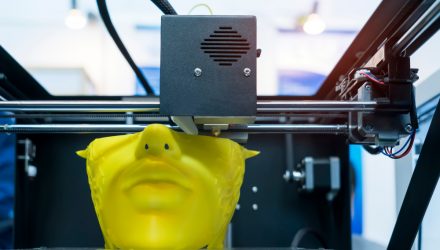The 3D Printing ETF (CBOE: PRNT) may not be the first ETF that comes to mind regarding investment ideas that could be reshaped for the better when the coronavirus is finally vanquished, but with the pandemic’s deep impact on manufacturing and supply chains, the lone 3D printing ETF merits consideration.
PRNT debuted nearly three years ago as the first US-listed ETF dedicated to the 3D printing theme. The fund is one of two passively managed products from New York-based Ark Investment Management. ARK believes 3D printing will revolutionize manufacturing by collapsing the time between design and production, reducing costs, and enabling greater design complexity, accuracy, and customization than traditional manufacturing.
“As a result of these challenges, this crisis brought 3D printing into countless people’s lives for the very first time. For many, their introduction to 3D printing technology has been personal protective equipment (PPE) or testing equipment—like a face shield, mask, or nasal swab—helping them stay safe. That’s a profound human experience,” reports Industry Week.
Plenty of Potency
PRNT is higher by more than 24% over the past 90 days, but that could be just the start of something more substantial.
“Well beyond this pandemic, the recent lessons we have learned from 3D printing will propagate throughout future-minded industries and into consumers’ lives in four critical ways. Supply chains will transform; creativity and design will accelerate; entire ecosystems will realign, and values will progress,” notes Industry Week.
ARK believes 3D printing will revolutionize manufacturing by collapsing the time between design and production, reducing costs, and enabling greater design complexity, accuracy, and customization than traditional manufacturing. For its part, DoD has long used 3D printing.
Adding to the allure of PRNT is the role that 3D printing can play in environmentally conscious portfolios.
“Environmental benefits are inherent to 3D printing—from lower distribution emissions to more eco-friendly materials, to the fact that less material is required for production, We’ve known for some time that more sustainable production is table stakes for companies that want to compete in the future,” reports Industry Week.
For more on disruptive technologies, visit our Disruptive Technology Channel.
The opinions and forecasts expressed herein are solely those of Tom Lydon, and may not actually come to pass. Information on this site should not be used or construed as an offer to sell, a solicitation of an offer to buy, or a recommendation for any product.

